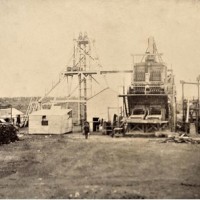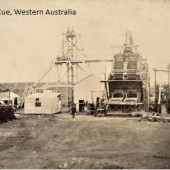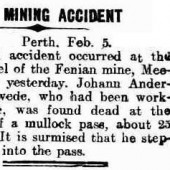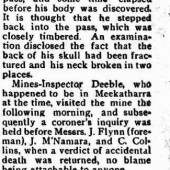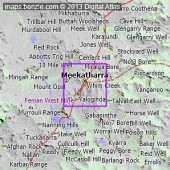Johann Adolf ANDERSEN
Age at Death37
Date Of Death4 February 1918 : Reg 7/1918 Murchison (Registered as Johan)
Place Of BirthSweden
OccupationMiner
Spouse's NameMarthine Christina Sofie OLSEN
Name Of Mine On Which Last Employed
Fenian GM, Cue, Meekatharra, Western Australia
Diagnosis or cause of accident
Stepped backwards and fell down the shaft.
Place Of Burial
Meekatharra Cemetery, Western Australia
Submitted by
Eric Chamberlain - Volunteer
MSW
Married
District
Cue
Cause of Death
Mine Accidents
Place of marriage
Kalgoorlie, 1908 - Confirmation RQD Given the District Registrar notice of their intention to marry : — Johann Adolf Anderson and Marthine Christina Sofie Olsen, both of Brownhill - https://trove.nla.gov.au/newspaper/article/211769263?searchTerm=Anderson%20marthine&searchLimit
Other Information
ANDERSEN Johan d. 5 Feb 1918 age 41 Methodist Section – Murchison death cert 7/1918
The Fenian gold mine (GML 477) is on the main Paddy's Flat line of lode about 1 kilometre east of Meekatharra. The Ingliston Extended mine borders it to the north, and the Marmont mine to the south. A modern abandoned open pit now marks the site developed in the 1990's.
The mine was initially pegged by F. Osborne and T Ryan in July 1903. It was initially worked at a loss. In October 1905 they purchased a battery from the Champion Mine Nannine. The mine was then developed by a small Perth syndicate of six men, with W.H. James the largest shareholder owning 380 of the 1200 shares in the company. The syndicate can be compared to Ebenezer Scrooge in its handling of the mine. A certain meanness pervades its actions from 1906 when they started development to 1923 when they sold the mine to the Ingliston Consols group.
These men must have started with significant funds already to be able to equip a fully functioning mine to the point of producing gold. Once running it produced 4000 pounds per month in dividends for the six shareholders, a small fortune in today's money. The syndicate was not on friendly terms, and in 1912 James took the other shareholders to court as they had approved a donation to a charity. James stated it was not the role of the syndicate to donate money to charitable causes, and didn't see why he should have to do this as the largest shareholder. He lost the action, and was forced to donate money to a hospital. The fuss was over 15 pounds.
The battery was gradually extended so by the end of the syndicates term it had a 20 head battery, cyanide and filter plant, and much other machinery, and was employing over one hundred men. The reef ranged from 11 to 18 feet wide.
Sam Carson (35) died from a fall of earth at the mine in 1907. In 1918 Swede Johann Anderson was killed when he fell into a shaft at the no. 3 level. The mine was being operated in an unsafe manner placing the miner's health in danger. These short cuts were taking place to save money. When the Inspector of Mines would visit the practices stopped, only to return again after he had left. Facilities normally associated with mines of the time were not provided for employees. The wages were also poor in comparison, not helped by lavish dividends being paid to the shareholders.
When the miners complained there was no facility to dry their wet clothes, the company burnt the clothes, leaving the miners nothing to wear to continue working. This last action sent the employees over the proverbial edge, and in 1916 there was a strike that lasted several months. Many left the district to seek employment on other mines elsewhere in Western Australia. The arbitration court eventually gave the men a pay rise and they returned to work.
In 1918, it is reported the mine has produced 384 105 pounds of dividends to its six shareholders. The last crushing was found in 1919, and it is thought the rich chutes the company was mining ran out. Based on a geologist's report that there was likely more gold at depth, the neighbouring Ingliston Consols took over the mine in 1923 and re-opened it in conjunction with its own mine.
Shears and cross shear veins carry valuable gold in this mine. The main ore channel in the mineralised shear zone strikes north north-east, dips east, with numerous milky white quartz veins. The ore body at Fenian is narrower than neighbouring mines, with a higher proportion of quartz, and a complex system of large cross veins.

